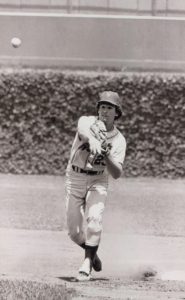 Doug Flynn (Photo courtesy of Jacob Kanarek, From First to Worst)
Doug Flynn (Photo courtesy of Jacob Kanarek, From First to Worst)
It was one tough week for Mets fans. There I was at Citi Field on Sunday, July 30, having a great time with the Mrs., the boy, and his friend. I had my first in-person view of Justin Verlander in a Mets uniform. He dominated the Washington Nationals, a team that shamelessly dumped its stars after winning the World Series that had eluded the franchise since it debuted in Montreal in 1969. (The ’69 season should ring a bell with Mets fans.) I saw him with his 250th career game and his sixth as a Met.
And then some 48 hours after rolling past the Nats, 5-2, the Mets were in the same boat as rudderless Washington—without the benefit of a recent World Series victory.
At the end of March, as the Mets rode the short distance from Port St. Lucie to Miami for Opening Day, the team was among the favorites to win the World Series. Four months later 90 wins are out the window; 90 losses seem inevitable. Gone are Dave Robertson, Max Scherzer, Mark Canha, Tommy Pham, and Verlander. To be honest, without injured Edwin Diaz locking down close games, I had doubts that the Mets were true championship contenders. Having been a Mets fan for way too long, I am perpetually skeptical that the team will finish the job.
Owner Steve Cohen fired a warning shot in June during his odd meeting with the press. The Mets struggled so badly that month (7-19) that even a 6-0 start to July did little to move the needle (they went 8-9 the rest of the month). A few other struggling teams like the Padres and Angels doubled down at the trade deadline, but when you are under .500 and seven games out of the final Wild Card spot in a watered-down playoff system, with two pitchers pushing 40 and making over $40 million per year, the right thing is to cut bait. The Mets organization is light years behind Atlanta and the only way to even the playing field is to build from within. Free agents have rarely worked out for the Mets.
I would have liked to keep Verlander and at least entertain the concept of being competitive the next two years, but if you are going to retool, then trade your best chip. And Cohen threw all kinds of money in on these massive contracts he’d handed out, assuring the Mets would get the best prospects in return. That is exciting. You’d wish they’d gotten more pitching, but the experts were all impressed with the haul. Yet be warned that minor league busses and major league benches are filled with highly-touted prospects that never made it.
The future appears promising, but no one is excited about watching this team play now. That first post-trade game against the Royals—a team barely staying ahead of a historically bad and completely gutted Oakland team—seems like a harbinger of things to come. If the bullpen could have held it together for one night, it might have provided hope. Some teams get rid of high-priced headaches (see Scherzer, Max) and actually play better. That extra-inning loss to the Royals—followed by getting blanked in Kansas City and then blown out for the sweep—was a bad sign. How they called up all these scrubinees from the minors and didn’t at least give Luke Voit some at bats instead of letting him walk is the most questionable move of the week. The rest of the deals make sense on paper.
This isn’t the Midnight Massacre. I spent the first part of the summer editing a new edition of Jacob Kanarek’s From First to Worst about what happened in the years immediately following the 1973 National League pennant. I relived it all in this well-written book due out next year. I grew up a diehard fan during that time, for anyone who wants to compare what is happening now to that period—please stop. The “prospects” the Mets got from Cincinnati for Tom Seaver at the 1977 trade deadline were players the Big Red Machine didn’t want or need. There was no Steve Cohen writing big checks to get the best prospects or maybe the four players they got back in 1977 could have been 20-year-old stud minor league pitchers Mario Soto and Bill Caudill, infielder Ron Oester, 21, and a 24-year-old young infielder named Ray Knight, who had essentially taken over the Doug Flynn reserve role in Cincinnati. Knight would replace Pete Rose at third base for the Reds in 1979 and, of course, rock Shea with a World Series MVP trophy in New York in 1986. The post-trade 1977 Mets were held together by bailing wire. Joe Torre was a rookie manager in way over his head. The Mets were a dead club walking (and not hitting).
Many of today’s Mets fans, to judge from needy social media posts, sound awfully spoiled considering that the team has historically been pretty average. (Through 9,700+ games the Mets have an all-time .483 winning percentage.) To the people who constantly complained during a 101-win season last year, all I can say is: You really do have something to complain about now. See you in 2026.
On the Air
I got these conflicted thoughts down in preparation for my appearance on the air with Dan Reinhard on WKNY in Kingston, NY, on Monday, August 7, at 7 p.m.
Cubs Shout Out
I recently sat in the Wrigley Field bleachers, thanks to the seat-saving stylings of Bleed Cubbie Blue and Cubs by the Numbers co-author Al Yellon. Al sat with me at Citi Field when the park first opened and our book was new. It was good to finally return the favor and sit in God’s own sunshine!
